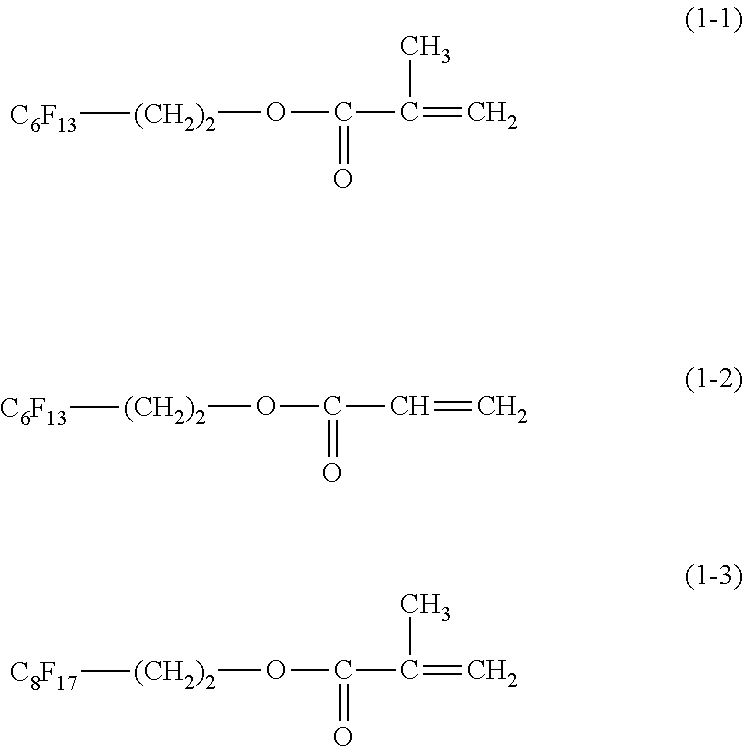Process for producing rigid foamed synthetic resin
a technology of rigid foam and synthetic resin, which is applied in the field of production of rigid foamed synthetic resin, can solve the problems of poor storage stability, adversely affecting moldability and workability, and insufficient storage stability, and achieves favorable storage stability, low viscosity, and excellent adhesiveness and flame retardancy. excellent
- Summary
- Abstract
- Description
- Claims
- Application Information
AI Technical Summary
Benefits of technology
Problems solved by technology
Method used
Image
Examples
preparation example 1
Production of Polymer-Dispersed Polyol (W1)
[0182]Into a 5 L (liter) pressure reactor, the base polyol (W′), monomers and AMBN as the polymerization initiator were loaded in the ratio shown in Table 1, and the temperature was raised with stirring, and the reaction was carried out for 10 hours while the reaction solution was maintained at 80° C. The monomer conversion reached 80% or above. After completion of the reaction, the unreacted monomers were removed by 2 hours of vacuum deaeration with heating at 110° C. at 20 Pa to obtain polymer-dispersed polyol W1.
[0183]The hydroxyl value and viscosity at 25° C. of polymer-dispersed polyol W1 and the content of polymer particles in polymer-dispersed polyol W1 are shown in Table 1 (the same applies hereinafter).
preparation examples 2 and 3
Production of Polymer-Dispersed Polyols (W2) and (W3)
[0184]Into a 5 L pressure reactor, 70 mass % of the mixture as the base polyol (W′) shown in Table 1 was loaded, and a mixture of the rest of the mixture as the base polyol (W′) and monomers and a polymerization initiator (AMBN) was fed over 2 hours with stirring while the temperature was maintained at 120° C. After completion of the feeding of the entire mixture, stirring was continued at the same temperature (120° C.) for about 0.5 hour. In Preparation Examples 2 and 3, the monomer conversion reached 80% or above. After completion of the reaction, the unreacted monomers were removed by 2 hours of vacuum deaeration with heating at 120° C. at 20 Pa to obtain polymer-dispersed polyols W2 and W3.
preparation examples 4 to 6
Production of Polymer-Dispersed Polyols (W4), (W5) and (W6)
[0185]Into a 5 L pressure reactor, Polyol X, Polyol Z1 and macromonomers were loaded in the ratio shown in Table 1, and while the temperature was maintained at 120° C., a mixture of monomers and a polymerization initiator (AMBN) was fed over 2 hours with stirring. After completion of the feeding of the entire mixture, stirring was continued at the same temperature (120° C.) for about 0.5 hour. Then, the unreacted monomers were removed at 120° C. under reduced pressure over 3 hours to obtain polymer-dispersed polyols W4, W5 and W6.
TABLE 1Preparation Example123456CompositionBase polyolPolyol X19001,4209001,5751,3501,350of polymer-(W′)Polyol Z19008301,125675900900dispersedPolyol Z2450225polyol (W)Monomer havingAN150400400187.5polymerizableVac600450450unsaturated bondMMA350350FMA300300187.5Polymerization initiator · AMBN30303014.214.214.2MacromonomerMacromonomer M128.528.5Macromonomer M228.5Content of polymer particles (mass %)2...
PUM
| Property | Measurement | Unit |
|---|---|---|
| hydroxyl value | aaaaa | aaaaa |
| hydroxyl value | aaaaa | aaaaa |
| hydroxyl value | aaaaa | aaaaa |
Abstract
Description
Claims
Application Information
 Login to View More
Login to View More - R&D
- Intellectual Property
- Life Sciences
- Materials
- Tech Scout
- Unparalleled Data Quality
- Higher Quality Content
- 60% Fewer Hallucinations
Browse by: Latest US Patents, China's latest patents, Technical Efficacy Thesaurus, Application Domain, Technology Topic, Popular Technical Reports.
© 2025 PatSnap. All rights reserved.Legal|Privacy policy|Modern Slavery Act Transparency Statement|Sitemap|About US| Contact US: help@patsnap.com


